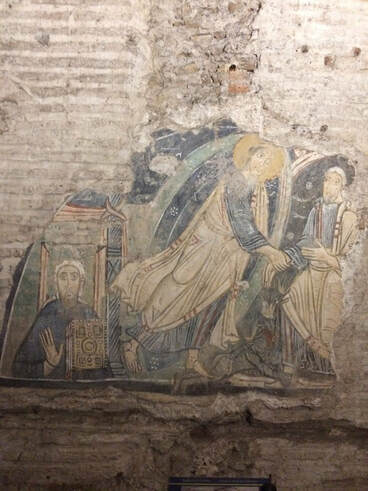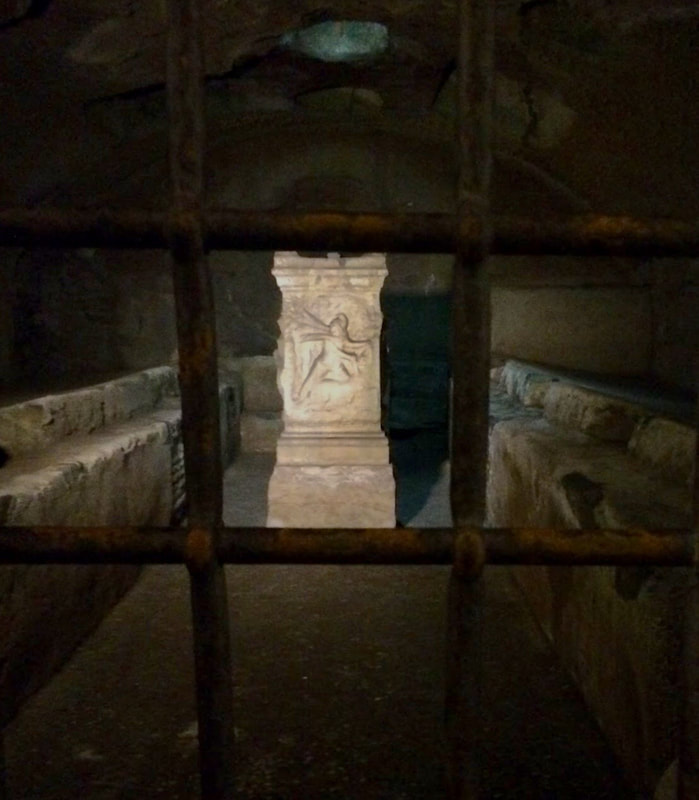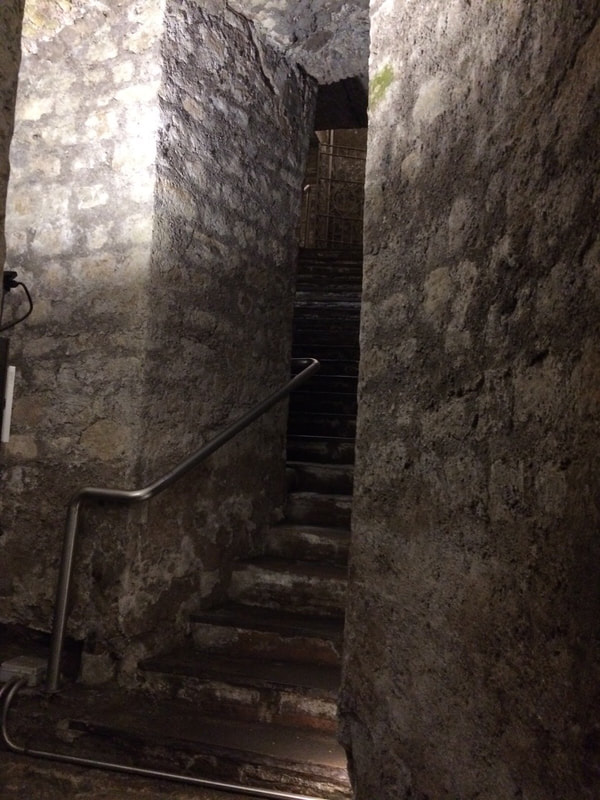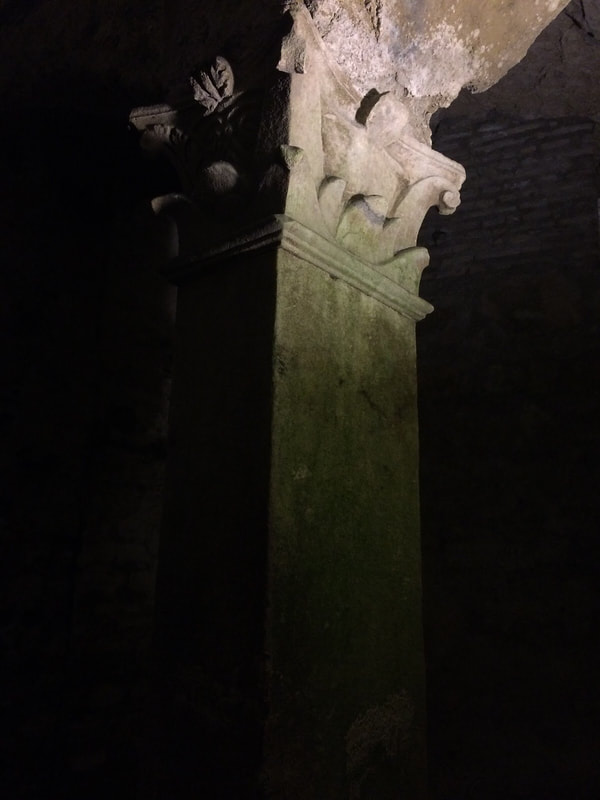|
3/4/2019 3 Comments Below the Back Corner Rome: The Eternal City. The capital of Italy has long been respected and revered as the capital of one of the most powerful and ancient empires, along with housing Renaissance masterpieces and being the home of Christianity. Large sites, such as the Colosseum and the Pantheon, showcase ancient Rome’s finest workmanship and celebrate the majesty of the Roman Empire. Modern-day Rome stands atop many eras of Roman history, and one small church tucked behind the Colosseum offers a more intimate and in-depth look at the layers from which Rome was built. The Basilica of San Clemente al Laterano stands quiet and unimportant in a compact neighborhood. Built in the twelfth century, it stands small and inconsequential; just another of the many basilicas in Rome. But its worth lies far beyond the façade . . . and deep under the foundation. Enter the ground level, and you see a typical basilica: an apse, crucifixes, pews, an altar, and small chapels dedicated to saints. But tucked in a back corner, sits an old and splintering entryway into another time and world. Open the door, and you stand atop a stone staircase, looking into darkness. A cold air hits you, smelling of mildew and age. A small light illuminates the stairway, causing twisting shadows to fall around you. The door creaks shut and you descend the uneven staircase. Stone corridors break off from where you stand at the bottom of the staircase, and displays of crumbling frescoes, fragments of sculpture and columns, and ancient artifacts line the walls. You’ve reached the original Basilica of St. Clement, built in the fourth century. This church was originally built to honor St. Clement, the fourth bishop of Rome. The damaged frescoes portray scenes from Christian canon, as well as scenes from St. Clement’s life and legacy. Catholic canon identifies Clement as the “fellow laborer” in Christ, spoken of by Paul in Philippians 4:3. St. Clement was banished by Emperor Trajan and sent to a stone quarry, where he was later taken and cast into the Black Sea, becoming a martyr. His relics are encased in a shrine in the upstairs basilica. Small rooms are connected by twisting passages and corridors, and all lead to a large central room, empty, save for a large canopied altar at the far end. Mosaics, bas-reliefs, and frescoes decorate this abandoned altar. Turn your back to the altar and you find a side corridor, holding a shrine and a large mosaic of two apostles. Behind the mosaic sits another staircase--much smaller and steeper, leading to the final level: a pagan sanctuary. The air becomes much more still and you can hear water rushing somewhere behind the stone walls. This short flight of stairs leaves you behind a wall and a set of thick columns. The ceiling is much lower, and the stone has patches of moss and mildew. This portion is much more compact and low, creating an oppressive feeling, almost claustrophobic. The air is heavier here, and there’s a heavy feeling that commands silence. Barred chambers line the left wall as hallways branch away, twisting behind large walls and columns into darkness. A large chamber stands on the left, stone benches lining the entire room with a single altar in the center, decorated with a bas-relief of this temple’s god: Mithras. This is the sanctuary of the Mithraic cult that worshipped here in the first century. The bas-relief depicts Mithras in his most famous position: slaying a bull. The image is of Mithras stabbing a white bull in a cave after overpowering it. The cave is the reason all Mithraic temples are underground, and these reliefs are the some of the only surviving materials of Mithraic theology. The Mithraic cult is considered the rival of early Christianity in Rome and was suppressed and eliminated at the end of the fourth century. Hardly anything is known of the rituals or beliefs of this cult, only rare inscriptions from sculptures, and a couple references in passing from ancient Roman writers. One writer, St. Jerome, provides insight into degrees of initiation and hierarchy within the cult. He described seven levels of initiation in association with seven planets, deities, or animals. The actual rituals for such initiations are still unknown, but Jerome’s short account, as well as a strip of old mosaics found in Ostia, a city just outside Rome, give an idea of what the ceremonies may have included. Farther down the main hallway sits a gaping hole behind bars. Peering through the bars, you see only total blackness. Sending a meek, “echo!” through the gate, the sound seems to be sucked away, with only a small echo bouncing back—clearly a large room or hallway extends beyond the emptiness. There’s no rhyme or reason to the set-up of this place, just odd bends and turns that disappear behind walls into darkness and thin passageways. An ancient, mysterious feeling lingers here, and it grows as you realize real people lived and breathed and worshipped here. Walking through the silent, twisting hallways, you feel the need to check over your shoulder, and you slowly register just how much ground and stone lies between you and the surface of the earth. Retracing your steps through the silent spaces you upset the still, cold air. The ancient rocks, mosaics, and fragmented pieces hold stories and memories no one will ever know. The stories will sit silent and unknown, hidden in the depths of the earth, forever. The past has been lived in, and time moves on around the markers of ancient lives, leaving us standing at the brink of the unknown, so close and yet so far from the ancients. Sara Malmstrom returned from a two week trip to Italy in January 2019 and has loved journaling her experiences. She is a sophomore in high school who loves participating in speech and debate, learning Spanish through intense immersion, and reading great books. She has been classically trained in ballet for six years, and is planning to continue her studies through college.
3 Comments
Cathy Esplin
3/12/2019 11:12:34 pm
Sara,
Reply
Sunny Berkholder
4/18/2019 09:52:11 am
Sara- This is beautifully written. As I read your words I feel like I am experiencing it first hand.
Reply
Leave a Reply. |
Archives
May 2019
Topics |
|
©History is the Hook, 2021
|






 RSS Feed
RSS Feed